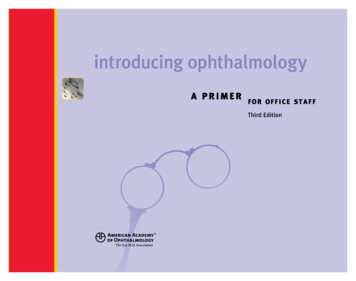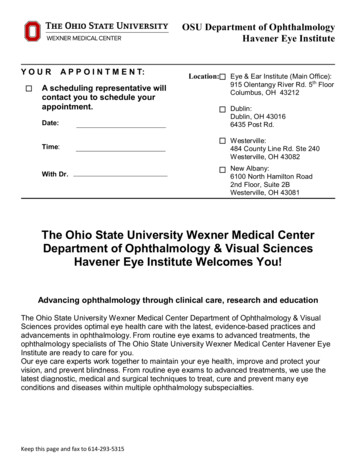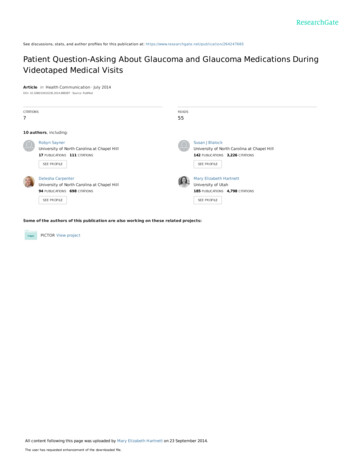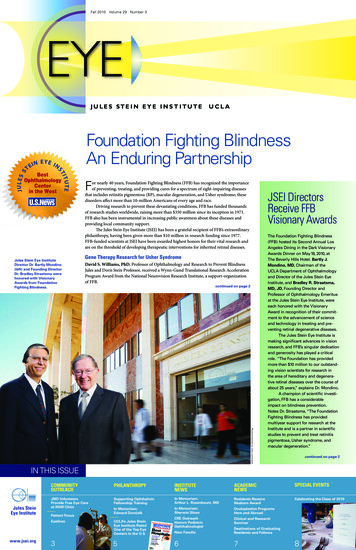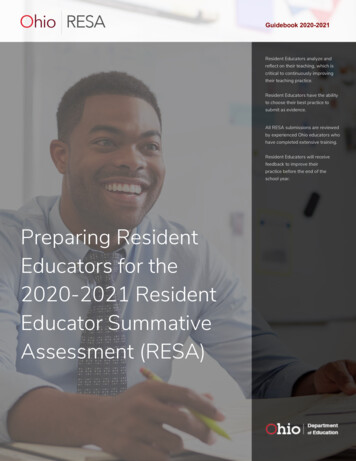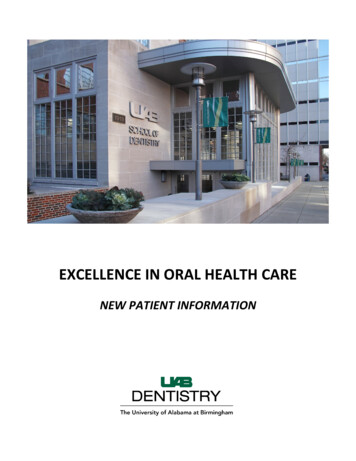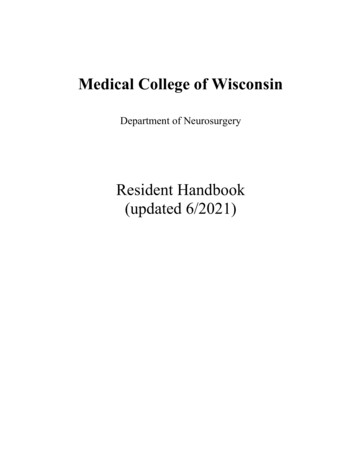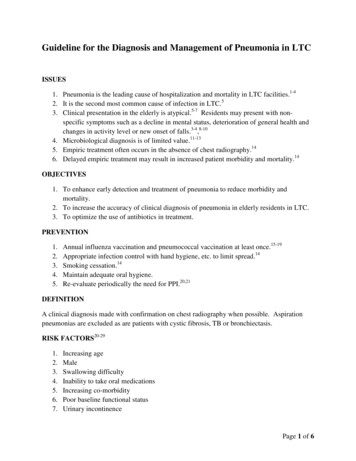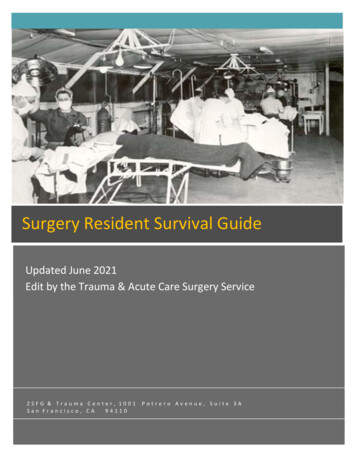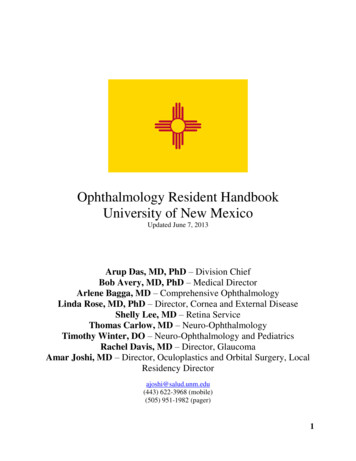
Transcription
Ophthalmology Resident HandbookUniversity of New MexicoUpdated June 7, 2013Arup Das, MD, PhD – Division ChiefBob Avery, MD, PhD – Medical DirectorArlene Bagga, MD – Comprehensive OphthalmologyLinda Rose, MD, PhD – Director, Cornea and External DiseaseShelly Lee, MD – Retina ServiceThomas Carlow, MD – Neuro-OphthalmologyTimothy Winter, DO – Neuro-Ophthalmology and PediatricsRachel Davis, MD – Director, GlaucomaAmar Joshi, MD – Director, Oculoplastics and Orbital Surgery, LocalResidency Directorajoshi@salud.unm.edu(443) 622-3968 (mobile)(505) 951-1982 (pager)1
Table of Contents1. Prior to Arriving .4Paperwork.4Call Schedule .4Vacation .42. Rotation Schedule and contact information .5Pittsburgh Residents .5Tufts Residents .5Important Numbers .53. Orientation.74. Practical Information .10Apartments .10Directions .105. Clinical Information .12UNM schedule .12Resident Clinic .12Consults .13Trauma .14Operating Rooms .14Dictation .14Resident lectures .16Journal club .16Grand Rounds .166. New Mexico Eye Associates/Dr. Weinstein visit schedule.17Directions to NMEA .17Schedule .188. PowerChart Instructions .19Setting default note types .19Writing consults and operative reports .192
Making/using note templates and auto text.19Booking an OR for emergency cases (after hours) .20Accessing electronic resources from home .209. Goals of the Rotation .22Educational Rationale .22Specific Goals and Objectives .22Obtaining core competencies .2310. Call Schedule .273
1. Prior to ArrivingPaperwork: Contact Graduate Medical Education—Kymbra Williams—at 505-272-6225(or e-mail KDWilliams@salud.unm.edu) to make sure all your paperwork isin order. UNM needs at least 2 months to process your paperwork and get you atemporary NM license and VA credentials. The VA then takes extra time toget you into their system. You will need to submit fingerprints and have licensing paperwork certifiedby a notary public. You also need to have your immunization records andphysical forms filled out and signed by a physician. Online items: NPI, Novell Account, Powerchart training, PACS account,HIPAA training.Call Schedule: We recommend that you and your co-resident(s) work out any changes inthe call schedule well in advance of arriving in NM and submit them toTerry Walton (twalton@salud.unm.edu). Call should be equitable, with consideration of holiday and weekendcoverage. No one resident can take more than seven consecutive nights of call underany circumstances.Vacation: Pittsburgh: 2-3 days off. Tufts: 4-5 days off Email Dr. Joshi with your vacation request at least 45 days in advance.Vacation requests made with less than 30 days of notice may not beapproved due to clinic guidelines. Email your co-resident to switch call (and cover consults if during the UNMrotation) while you are away. Email Terry Walton with final changes to the call schedule Please do not take an entire week of vacation while at UNM because thisleaves your co-resident to cover consults and call while at the VA. Notify the UNM clinic so they can block off the resident schedule asappropriate4
2. Rotation Schedule and contact informationPittsburgh ResidentsJohn Legarretalegarretaje@upmc.edu(716) 510-5991Jacek Kotowski kotowskij@upmc.edu(630) 272-2911Alison Zambelli zambelliam@upmc.edu(412) 551-6888Victoria Changchangvs@upmc.edu(305) 215-0904Jared Knickelbein knickelbeinje@upmc.edu(412) 760-8004Salwa Azizabdelazizs@upmc.edu(801) 703-11796-10-2012 through 8-17-20128-19-2012 through 10-19-201210-21-2012 through 12-14-1212-16-2012 through 2-22-20132-24-2013 through 4-19-20124-21-2013 through ?6-14-2013Tufts ResidentsAvneet Sodhiavneetksodhi@gmail.com7-1-13 through 9-29-2013(410) 652-1108Jennifer Renzjenrenz@me.com9-30-2013 through 12-29-2013(505) 227-4545Claudia Bartolini claudiabartolinister@gmail.com12-30-2013 through 3-30-2014(603) 305-3291Kevin Sitkokevinsitko@gmail.com3-31-2014 through 6-27-2014(919) 624-5047Important NumbersTufts pagerTufts apt505-951-0640505-821-9584Pittsburgh pagerPittsburgh apt505-951-0641505-797-4181UNM Clinic505-272-2553505-272-3856505-272-0960Main number (voice prompts: appts, etc.)Back lineBack MD line5
Terry ud.unm.eduUNM operatorUNM main ORUNM Dictation505-272-0190505-272-2626505-272-9007VA operatorVA eye clinic505-265-1711 (Dial 1 and then extension)x 4185Mark SchluterpagercellPhilip 94-6251NOTE: Dr. Watkins turns pager off after 10. Call him at home!Arup Daspagerhome951-0636292-0320adas@salud.unm.eduBob Arlene duLinda m.eduAmar nm.eduShelly eduRachel DavisStarting October 2013Tim WinterStarting July 2013951-0637269-6195mschluter@salud.unm.edu6
3. Orientation Start at UNM:o Park at patient parking located off of Lomas (red circle below - gonorth on Yale and turn right at the roundabout; you will see theparking structure on the right). After you receive your badge, you willpark at the Lomas parking structure directly across from the hospital(blue circle below). You must only park on the levels where the pillarsread "SOM" and make sure your parking placard is on your car dash.o At 9am, go to the second floor of the ACC wing of the UNM Hospital(Surgery Department). Terry Walton in Ophthalmology will take youto obtain prescription privileges and then to the GME office to get asecurity badge. She will also set up powerpoint training if you havenot already done this online and assist you with access codes. Drive to the VAo The VA main hospital has 4 wings (A,B,C,D, shaped like an ‘H’)7
o Park in patient/visitor parking for your first day. Go to the PersonnelOffice (Building #4, 2nd floor, room 218), “Processing and RecordsSection,” and ask for the person who can assist you in getting yourappointment letter. You need this letter to get your badge, parking,access codes, etc. They’ll fingerprint you and sign your appointmentletter.o Next, go to the main hospital (building 41), floor 3, Room 3B-105(near the PACU) and ask for Gerald Casteel. If he is not there, go tothe surgical secretary office at 3B-112 and they will page him.Gerald’s phone extension is x4946. He will help set up your computeraccess code, long distance phone code, and dictation code. This maytake up to two days to process. Gerry will call or page you when yourcodes are ready. If he is not in, ask for Pauline.o Next, go to Pharmacy Administration (room 1D-116, 1st floor mainhospital next to outpatient pharmacy) to provide your prescriptionsignature and obtain your prescribing privileges. You will need to takeyour UNM DEA # (blue card from UNM) with you.o You’ll also need to get your parking permit and ID badge. This isdone at the VA police station (1B-150), which is located next to theER on the first floor of the main building. Bring your car’sregistration number and insurance card.o For VA dictation instructions, go to the VA main webpage and in the“Clinic Corner,” click on “dictation instructions.”o You are required to complete Fire Safety at the VA. The process haschanged so please ask on of the technicians to assist you with this.o You need a special badge to get in and out of the OR at the VA; thishas to be requested by each resident at the surgical offices (3B-112,ask for Pam Tucker).o See Joyce in the Eye Clinic to get the codes to the locker room andlocker for the OR at the VAo See Edith in the OR, 3C-133 to get a scrub code set up for the OR.o In 1-2 days, go to BC-101 (basement of Main hospital) to get yourcomputer password. They will give you both your network and EMRcredentials.o If you start at the VA, go to the Eye Clinic and introduce yourself. Go back to UNMo Finish any remaining orientation tasks and then meet with Dr. Joshifor a clinical orientation8
o If you start at UNM, you will need to be in the Eye Clinic at about3:00 to start seeing patients.You are done orienting.9
4. Practical InformationApartments La Paloma Apartment Complex – 6001 Moon St. NE, Albuquerque, NM87111o Tufts: Apt. 3624 – (505) 821-9584o Pittsburgh: Apt. 1824 – (505) 797-4181 Your home institutions rent the apartments. Please contact them with anyconcerns regarding the maintenance or condition of the apartment and/orfurnishings. A cleaning service is scheduled by your home institution to clean theapartment the Friday prior to your arrival. Please contact your program ifthis is not being doneo Please request periodic carpet cleanings with your home institution.Directions To UNM hospital/clinics: From Moon, go left (away from the mountains) onAcademy and then right onto San Mateo. Move to far left lane and take 25South. Exit at Lomas and turn left. At the hospital turn right on Stanfordand then left on Campus. The entrance to the garage is on your left. (redroute on map)o Alternate Route: Left on Academy, left on Wyoming, right on Lomasafter I-40 overpass To OSIS: From Moon, go left (away from the mountains) on Academy andthen right onto San Mateo. Move to far left lane and take 25-South. Exit atLomas and turn left. Turn left at University Blvd. OSIS will be on yourleft—turn into the staff parking lot on the far side of the building. To VA: From Moon, go left (away from the mountains) on Academy andthen left onto San Mateo. Stay on San Mateo until it ends at the entrance tothe VA campus. Follow the main VA drive around until you see the staffparking lot on your left. If your section of the staff lot is full, there is anoverflow lot behind the hospital (behind the Air Force lot) (blue route onmap)10
VA to UNM: From the main VA entrance, turn left onto Gibson. Turn rightonto Girard and then follow it past Central. Turn left on Campus and theLomas parking structure will be on your right11
5. Clinical InformationUNM scheduleAM(until 2 PM)PMOtherMondayDas ORTuesdayAvery ORWednesdayBagga ORThursdayRose nic/consultsFridayAcademictime (untilnoon)Clinic(with VAresident)/consultsLecture at 5PM Dr. Lee operates on Wednesday mornings and Dr. Joshi operates on Fridaymornings (except for the first Friday of each month). Residents are notexpected to be present for these sessions, but can attend at their (and theirattendings’) discretionResident Clinic Resident clinic is largely for acute care patients. Please follow patients foracute illnesses, and then refer them to the appropriate providers (MD or OD)for long-term care. Lasers and minor procedures should be done at the end of clinic so as not todisrupt the rest of the clinic flow. The attending in clinic should be notifiedof any procedure requiring a consent. Indicate the start and stop time of theprocedure in the chart for billing purposes. If you schedule a patient or call an inpatient down to clinic, please let thefront desk know. Visual fields and fluorescein angiograms should be scheduled: for emergentcases we can make exceptions. Imaging studies and labs can be ordered in PowerCharto For imaging studies, go to the “Chart” menu and select “Ad HocCharting.” Select Radiology and fill out the form as appropriate. Hitthe check mark button on the upper left to complete the request.o For labs, use the Power Orders section. When OR is canceled, we may call you to see walk-in patients and emergentcases.12
If patients are seen on weekends, please leave a copy of the clinic log, chartor name and medical record number for the clerks. This will help the staffwhen a patient arrives for follow-up. Please clean up after yourself after hours; turn off lights and equipment Medication in the clinic is not for dispensing to patients. If a patient needs amedication, write a prescription. The clinic has a minimal budget and itcannot support this practice. It is also a violation of the University Hospitalpharmacy policy. There is a Resident’s box in the file room with charts that requires yourattention on a daily basisConsults Consults will be posted on the Resident’s board. Please call to check onthem. Inpatient consults should be done before or after regular clinic hoursunless it is an emergency. A call bag/resident kit is available in the clinic. If you take equipment from the clinic, put it back when you are done orplace it in the dirty instruments tray in the procedure room. Do notleave equipment in the call bag. All consults must be seen within 12 hours. Urgent consults should be seenimmediately. When you are in the OR (at the VA or UNM), please leave your pager on thetable so that staff can answer any pages while you are operating.o If you are on call, you may rarely have to leave the OR to go see anurgent consult—this takes precedence. If you have any questions about management, please contact the attendingon call. Serious eye injuries or patients who will need long term follow-upshould be discussed with the attending on call (ex: Stevens-Johnsonpatients, neovascular glaucoma, traumatic optic neuropathy). Enter all consults in Powerchart (see instructions in section 11). Pleasenotify the consulting service of your findings. All non-accidental trauma cases MUST be staffed by the attending physicianon call within 24 hours, positive or negative. Please call the attendingphysician when you receive notice of the consult (prior to examining thepatient). Do NOT document any findings in Powerchart until the attendinghas completed their exam. Notify the attending of all admissions to Ophthalmology. Admission H&Ps(work type 99, include outpatient medicines) and operative reports (work13
type 03) must be dictated. Discharge summaries (work type 01) should bedictated on the day of discharge. For all visual field consults, please make sure the patient is appropriate tocome to clinic (ie. not bedridden, in isolation, or attached to a million lines)and realistically able to take the test (appropriate level of consciousness andable to sit in the machine) before the patient is sent down to the clinic. Allvisual fields require an interpretation (can be done as a consult note).Trauma Fill out the New Mexico Eye Injury Registry form on all serious trauma,whether seen in the ER, inpatient consult, or clinic. Please fill out a form onany patient that requires surgery, a procedure, or admission to the hospitalbecause of eye trauma. Place the form in the box in the clinic or give it toTerry. Unless otherwise instructed by your attending, patients you take to the ORafter-hours for trauma (ruptured globes, canalicular lacs, etc.) should followup in the resident clinic until they are stable.Operating Rooms OSIS (Outpatient Surgical and Imaging Center), both main and satellite, islocated at 1213 University Blvd (see directions above). With the exceptionof emergency or inpatient surgeries, most eye surgery is done here. Mostcataract/anterior segment surgery is done at OSIS satellite (a.k.a. the cancercenter). Retina cases are performed at OSIS main.o Cases start at 7:30, so arrive by 7:15 The Main OR is on the 2nd floor of the hospital Scrubs are in a Pyxis machine in both locations. Talk to Josie at OSIS for acode. For emergency surgeries after hours, you are responsible for submitting theOR request form (previously called the blue card). Instructions are in thePowerChart instructions section of this manual.o During regular hours, Jessica in the clinic can help you with thisprocess.Dictation14
Dictate all cases for which you were primary surgeon within 24 hours of surgery(preferably immediately after the case):1. Dial 2-90072. Enter your 6-digit dictation code3. Enter work type:Op Report03Discharge summary01Letter28 (78 for outside MD)H&P994. Enter FIN Number (not MRN)5. Dictate (make sure to include the patient’s name, DOB, MRN, FIN, and dateof surgery)6. Press 5 to dictate another case, or if you’re done just hang up.Please make sure to put an attending attestation at the end of any dictation you do(eg. “Dr. was present for the entire procedure” or “Dr. was present for thekey and critical portions of the procedure and was immediately available”).For ruptured globes, please include characteristics of the wound, includinglocation, shape, size, and where you explored, in your dictation.15
6. Conference and Lecture SchedulesResident lecturesResident lectures are held every Monday afternoon at 5 PM in the Cibola Room(3600 BBRP). The lecturer may contact you to schedule an alternate time/place fora lecture. In general, the attending on call will be giving the lecture. Thefollowing exceptions are listed below:TBAPlease make sure to show up on time for these lectures. Contact the lecturer if youare unable to attend for any reason.Journal clubA journal club is held quarterly. Residents are responsible for presenting asynopsis of a given journal article. Dr. Bagga will e-mail you with dates andarticle assignments well in advance of a journal club.Tentative Dates: June 24, 2013, October 28, 2013Grand RoundsGrand rounds, both at UNM and as part of the New Mexico OphthalmologySociety, are held a few times a year. You will receive notification of any eventswhen they are upcoming.Tentative Dates: August 26, 2013, December 16, 201316
6. New Mexico Eye Associates/Dr. Weinstein visit scheduleAll of our residents spend at least one day at New Mexico Eye Associates(NMEA)—a large private multi-specialty eye practice—observing Dr. ArtWeinstein during one of his OR days. This provides residents with exposure to thesurgical techniques and OR protocols involved in high-volume private-practicecataract surgery. The length of time you spend with Dr. Weinstein will depend onyour interest as well as Dr. Das’ OR schedule. Please check Dr. Das’ OR schedulefor the Monday of your visit to Dr. Weinstein the week before your visit.Directions to NMEAFrom Moon, go left (away from the mountains) on Academy and then right ontoSan Mateo. Turn right at the next light (by Starbucks) and then right again atHarper St. Turn left into the first entrance. The surgery center (AAESC) is innorth side of the Presbyterian complex, just east of the NMEA office building.Park anywhere and enter on the east side of the Presbyterian building. Followsigns to the eye surgery waiting area.When you arrive, introduce yourself to the receptionist, Gloria, and ask her todirect you to Anne Dwyer. Ms. Dwyer will take care of you from there. NMEAhas a limited supply of extra scrubs, so it is easiest to wear your own. If you have17
any issues, you can contact Ms. Dwyer at (505) 681-7714 (mobile) oradwyer@eyenm.com.ScheduleTBA18
8. PowerChart InstructionsDetailed instructions on using PowerChart can be found online (you will receivethis information during your orientation). What follows are practical tips related tothis rotation.Setting default note types Select a patient and click on the Clinical Notes section of their chart. At the top of the page, click on the Documents menu and select Options Select the note type you want in the left box and hit the right arrow totransfer it to the right box. Click OK. You should select the following note types:o Consult Note Ophthalmologyo Operative Reporto Brief Operative Noteo History and Physicalo History and Physical UpdateWriting consults and operative reports Open the patient’s chart and go the Clinical Notes section Click on the Add icon (piece of paper with a yellow asterix) Select your note type in the first drop-down menu (you should already haveset up your default note types)o If you have not yet set up your defaults, right click on the drop-downmenu and select Complete from the Document Type List menu Make sure to forward your consult notes to your attendings as necessaryMaking/using note templates and auto text PowerChart allows you to use templates for your notes as well as to savesnippets of text to insert using key phrases. For consults, create a new note of the type Consult Note Ophthalmologyo Click on the Templates icon (rubber stamp) and then selectOphthalmology consult. Hit Insert.o Fill in the note and insert the templates for medications, PMH, andallergies in the appropriate sections.19
You can use Auto Text to quickly complete operative reports withoutdictating. To make a new Auto Text, create a new note and select a segment of text(original or pasted in from somewhere else). Right click and select Save asAuto Text. Make a name for your text in the Abbreviation box(cataractAVERY, cataractBAGGA, strabismus, ROP you get the idea).Preceed the name with an “ ” sign. Hit Close. To use the Auto Text in a note, hit “ ” and then the name of your text.Booking an OR for emergency cases (after hours) For after-hours emergency surgeries, you need to contact the Main OR andbook the surgery using the electronic scheduling system From the CernerWorks – Applications webpage (where you normally launchPowerChart from), select Appt Book in the Scheduling folder. Log in with your usual PowerChart credentials Next to the calendar, you will see a window labeled Bookshelf. Hit theAppointment tab in this window. Hit the “ ” button next to Appointment Location and select UH Maino If you do not have this as an option, your account may not be set upcorrectly. You may need to request help from your attending or theOR scheduling desk. Hit the “ ” button next to Appointment Type and select the appropriatetype (usually SN Emergency Surgery) Complete the Person Name and Primary Surgeon fields Enter a description of the surgery in Private Surgical Comments Hit the button labeled “Move ” In the window that pops up, find the applicable procedure using the searchbox and double click it (eg. ruptured globe). Fill in as much of the information in the right-hand section as possible andthen hit OK. Hit Request to submit the booking. Contact the main OR to make sure the booking has come through.Accessing electronic resources from home You can access iSite (PACS) from home by going htmlo Log in and then log in again in the left-most column.o iSite is available in the PACS folder.20
o Currently PowerChart access does not appear to be available.21
9. Goals of the RotationEducational RationaleThe New Mexico Rotation provides an intensive surgical and clinical experience ina broad range of diseases. The rotation consolidates a resident’s ability to provideprimary ophthalmic care and emphasizes blinding conditions in a population ofpatients distinctly different from those encountered in their home programs. Thesediseases include ocular trauma, severe diabetic eye disease, advanced cataracts,pterygium, and subacute glaucomas. The rotation involves a significant amount ofindigent care. In addition, Hispanic, Native American, and rural patients provideunique cultural issues and medical problems.Specific Goals and Objectives Appreciate the unique features of patients and health care delivery in NewMexico. Practice cost-effective health care and resource allocation that does notcompromise quality of care. Understand how medical practice and delivery systems differ from oneanother, including methods of controlling health care costs and allocatingresources. Coordinate with health-care professionals, including those from otherdisciplines, to provide patient-focused care. Facilitate the learning of students and other health-care professionals Diagnose and manage traumatic and toxic injuries to the eye and ocularadnexa (eg: alkali burn, lid laceration, orbital fracture, etc.). Recognize and treat hyphema and microhyphema, including complicationsof increased intraocular pressure and rebleeding. Perform surgical repair of simple and complex ocular adnexal injuries,including lacerations of the lacrimal drainage apparatus. Perform sampling for viral, bacterial, fungal, and protozoal ocular infections(eg: corneal scraping and appropriate culture technique). Describe the indications for pterygium excision and perform pterygiumexcision, including conjunctival or amniotic membrane grafting whenindicated. Perform routine and advanced cataract surgery and IOL placement. Implant different types of intraocular lenses, including Toric lenses.22
Diagnose and manage intra-operative and post-operative complications ofcataract and anterior segment surgery. Describe the instruments and techniques of cataract extraction, includingextracapsular surgery and phacoemulsification (eg. altering parameters,machine trouble-shooting, etc.). Describe the types, indications, and techniques of anesthesia for cataractsurgery. Describe the principles, indications for, mechanics of, and performance ofA-scan ultrasonography, keratometry, and calculation of IOL power. Perform basic non-laser refractive surgery techniques (eg: relaxingkeratotomy). Recognize, evaluate, and treat neovascular glaucoma. Recognize, evaluate, and treat trauma-related glaucoma Diagnose and manage posterior-segment trauma, including commmotioretinae, traumatic choroidal rupture, and Purtscher’s retinopathy. Describe the indications for and perform basic laser treatment for diabeticretinopathy. Describe the indications for and interpret retinal imaging technology (eg:fluoroscein angiography, ocular coherence tomography) and apply it tocomplex retinal or choroidal pathology. Perform scleral buckling. Describe the indications, techniques, and complications of pars planavitrectomy and assist in retinal surgery or perform parts of the procedureunder supervision. Diagnose and treat traumatic optic neuropathyObtaining core competenciesPatient care:Residents obtain competence in patient care in a wide variety of settings. Theseinclude their own Resident Clinic, specialty clinics run by attendings (ex: Retina,Cornea), and inpatient and outpatient operating rooms. In addition, the residentassumes first-call responsibility for inpatient consults and after-hours emergencies.The Resident Clinic allows them to develop their own practice styles and patternswith faculty input just one or two doors away. The clinic allows them theopportunity to provide continuing care to patients they initially see in urgent care,inpatient, and emergency room settings. Interesting or challenging patients arereviewed with attendings.23
As this is a third-year rotation, residents are expected to arrive having masteredhistory-taking and examination skills. Emphasis is placed on differential diagnosis,formation and implementation of treatment plans, and developing techniques forcounseling and educating patients.Surgery:A resident’s surgical experience here includes a spectrum of procedures that ar
1 Ophthalmology Resident Handbook University of New Mexico Updated June 7, 2013 Arup Das, MD, PhD - Division Chief Bob Avery, MD, PhD - Medical Director Arlene Bagga, MD - Comprehensive Ophthalmology Linda Rose, MD, PhD - Director, Cornea and External Disease Shelly Lee, MD - Retina Service Thomas Carlow, MD - Neuro-Ophthalmology Timothy Winter, DO - Neuro-Ophthalmology and .
